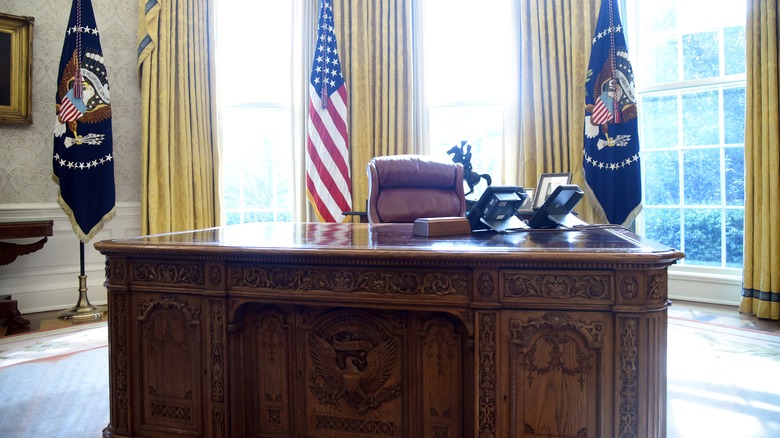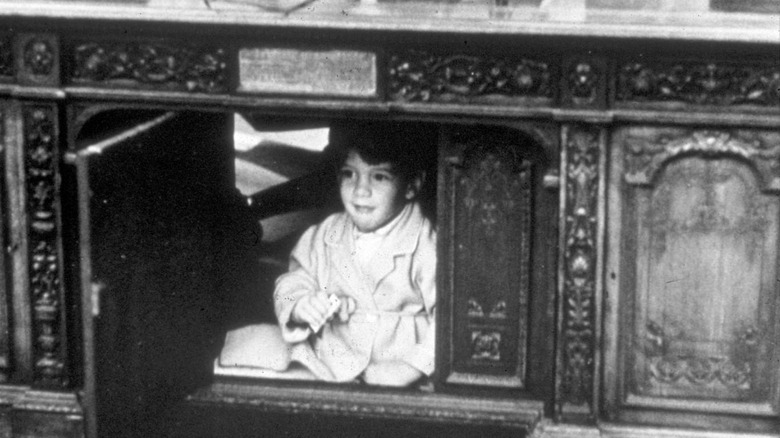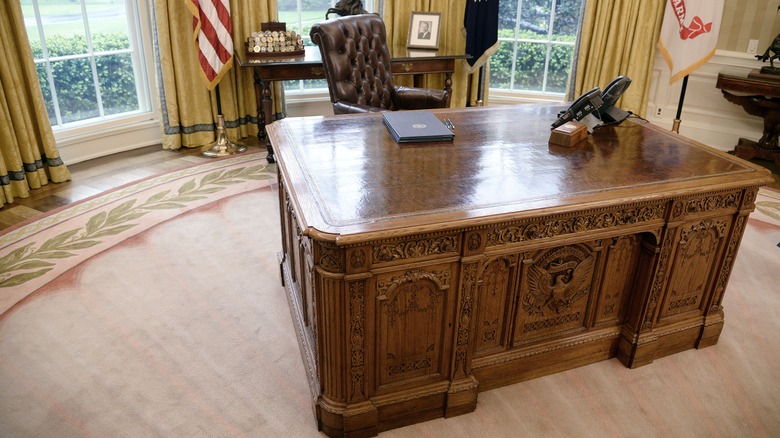How The Resolute Desk Got Its Name
The Resolute Desk is perhaps the most well-known piece of furniture within the White House. Pictures of the desk within the presidential Oval Office are relatively common, particularly when a president signs a bill into law or vetoes a bill, but its presence there only dates back to the 1960s, when John F. Kennedy was in office. Per The President's Desk, then-first lady Jackie Kennedy reportedly found the desk under a green cloth stored within the White House and her husband then requested it be brought into the Oval Office.
The desk became famous when, as reported by Iconic Photos, Look magazine photographer Alan Stanley Tretick took a series of candid photos of President Kennedy and his children, including one of young John F. Kennedy Jr. playing under the Resolute Desk while his father sat at it working. John F. Kennedy Jr. was born two weeks after his father was elected, and the photos emphasized the youth of the family in the White House.
John F. Kennedy Jr. made the Resolute Desk famous
Young John F. Kennedy Jr. particularly enjoyed the Resolute Desk because of the sliding panel at the front that he referred to as a "secret door," according to Our White House. The panel, however, was a modification made long after its original delivery. The desk arrived at the White House in 1880 as a gift from England's Queen Victoria to President Rutherford B. Hayes, per The Collector. The enormous desk is six feet long and weighs over 1,000 pounds. The oak used to construct it was sourced from a British Royal Navy ship named the H.M.S. Resolute. The ship was used in an 1852 Arctic expedition meant to find the remains of explorer Sir John Franklin and his crew, who had set out to find the Northwest Passage in 1845.
The H.M.S. Resolute was frozen in ice and left at sea until an American whaler found it in 1855 and steered it back to a port in Connecticut. The United States government bought the boat, restored it, and returned it to Queen Victoria as a gift. The boat was put back into service by the British Royal Navy for 20 years until it was decommissioned in 1876. Queen Victoria asked that the ship's wood be used to build desks and returned the United States' gift by sending one of the desks to the then-current United States president. According to White House History, President Rutherford B. Hayes used the desk on the second floor of the White House, home of the presidential offices until the construction of the West Wing in 1902.
The Resolute Desk traveled the country before making its way home
The desk remained on the second floor; President Franklin D. Roosevelt asked that the desk's knee opening be retrofitted with a panel carved with the presidential coat of arms. Per The Collector, Roosevelt brought the Resolute Desk back into the public eye via his famous Fireside Chats, which he broadcast while sitting at the desk. Roosevelt didn't live to see the panel installed, but it went in during Harry S. Truman's administration and became famous as John F. Kennedy Jr.'s "secret door," as highlighted in the Look magazine photographs.
According to White House History, after the death of John F. Kennedy, the Resolute Desk became part of a traveling exhibition and was on display in the Smithsonian museum from 1966 until 1977. When Jimmy Carter began his presidential term, he requested that the Resolute Desk be returned to the Oval Office. It has since been used by every United States president, although George H.W. Bush only used it for five months before requesting a different desk. Bill Clinton requested its return and it remains there today.
White House History reported that presidents have decorated the Resolute Desk in various ways indicative of their style and interests. Harry Truman famously displayed a plaque reading "The Buck Stops Here" while John F. Kennedy had a coconut paperweight dating from his time stranded in the Solomon Islands during World War II. Both Ronald Reagan and Bill Clinton used the desk to display the motto "It Can Be Done."


